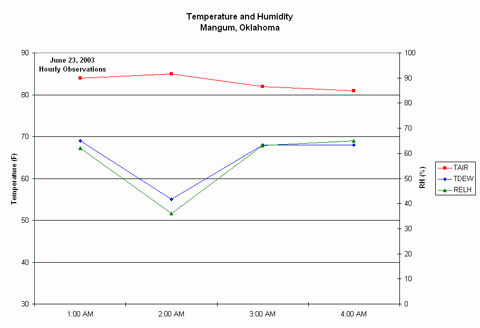

Assessment / Application Exercises
Plot the following sets of data ("Group 1", "Group 2", and "Group 3") on separate graphs. Plot temperature and dewpoint on the same graph. You may plot RH separately or on a right axis of the temperature graph. Plot the wind gust (WMAX) on a separate graph. You don't have to connect your plotted symbols for the wind gust graphs. With your teacher's permission, you may use a computer to plot Group 3. Answer the following questions at the appropriate times:
After Plotting Group 1:
Like these observations, most weather observing stations traditionally have recorded their data once per hour. What time of day were these observations taken (during daylight or nighttime hours?). How do weather conditions normally change during this time of day? Do the observations in Group 1 fit with your expectations of how weather conditions typically behave?
Group 1: TAIR, TDEW, and RH |
Group 1: WMAX |
 |
 |
| Click images to obtain larger versions. | |
These observations were taken in the middle of the night, between 1 and 4 a.m. I expect temperature to decrease during the night, and the temperature values show a slight cooling trend. I usually don't expect the winds to be as strong at night as during the day, but the 1:00 a.m. wind gust was over 40 mph. The wind gusts tended to slack off during the night. The 2:00 a.m. humidity observations (RH and TDEW) seem a bit out of place, but they return to their "normal" values at 3:00.
After Plotting Group 2:
Describe the weather conditions observed at Mangum between 2:00 a.m. and 3:00 a.m. and compare with the conditions before and/or after this period. What were the maximum temperature, minimum humidity, and maximum wind speed values, and when did they occur? Compare this graph with your Group 1 graph.
Group 2: TAIR, TDEW, and RH |
Group 2: WMAX |
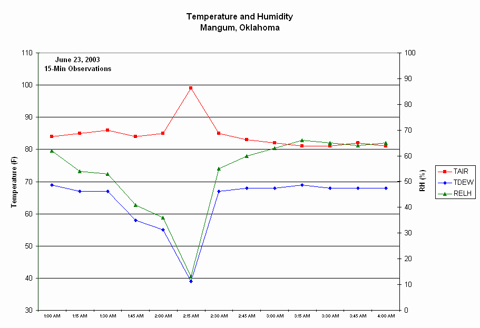 |
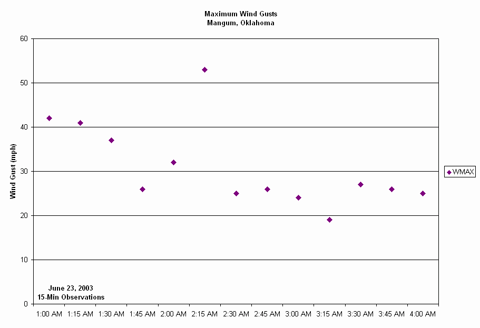 |
The temperature rose to just under 100 degrees at 2:15 a.m. At the same time the dew point and relative humidity dropped to 40 degrees and 10%, respectively. The temperature rise was 15 degrees. At the same time, this hot and dry air was accompanied by strong wind gusts (over 50 mph). The 2:00 a.m. observation from Group 1 now looks like it may have been the onset of the hot dry winds that occurred at 2:15.
After Plotting Group 3:
The phenomenon observed at Mangum is known as a heatburst. When thunderstorms weaken, they often eject strong downward gusts of wind, called downdrafts, beneath the thunderstorm. Usually, the downdraft contains moist air which evaporates beneath the thunderstorm and cools the downdraft, much like when moisture from your skin evaporates and makes you feel cooler. Sometimes, for reasons meteorologists don't understand, the downdraft contains dry air. When dry air descends, it compresses and warms rapidly.
Heatbursts were once thought to be rare events. From what you have seen in your plots, describe one reason why meteorologists would have thought they were rare. Also, in your answer, discuss which of these three groups of observations is adequate to observe heatbursts. Why do you think the word "burst" is used to describe this phenomenon?
Heatbursts are usually observed at night. Do you think it is possible for heatbursts to occur during daylight? If so, can you think of something that might prevent their observation during the day?
Group 3: TAIR, TDEW, and RH |
Group 3: WMAX |
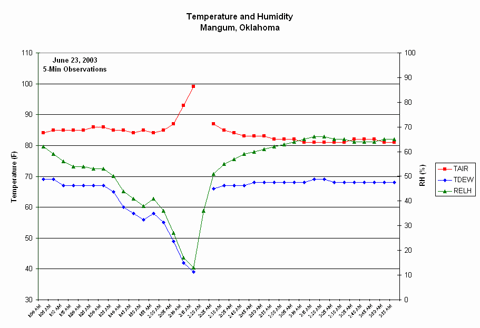 |
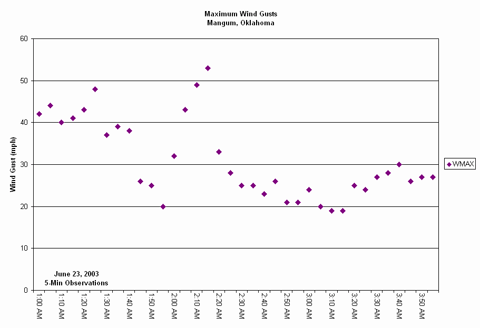 |
The Group 1 chart, consisting of hourly observations, does not clearly show the onset and duration of the heatburst. The entire event occurred in less than an hour. If standard observations were taken only once per hour, then most heatbursts would have gone undetected. The 15 minute data clearly depicts the heatburst, and the 5 minute data give more detail. Strong winds accompany the "burst" of hot and dry air. The term burst may signify a short duration event with strong winds.
Heatbursts are associated with temperature increases. If they could occur during daylight, they may be masked or obscured by the normal temperature increase (warming) that occurs during daylight hours.